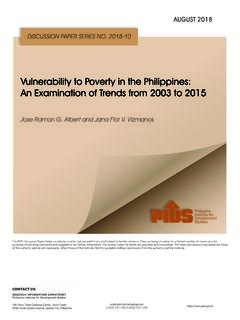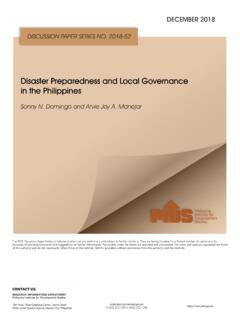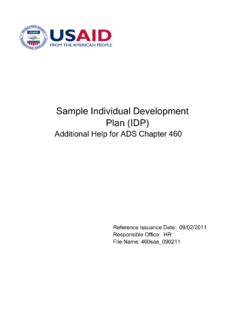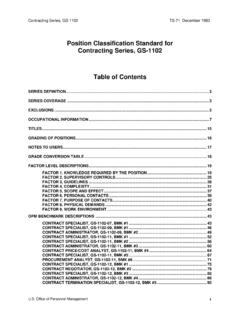Transcription of The Promises and Pains in Procurement Reforms in the ...
1 For comments, suggestions or further inquiries please contact:Philippine Institute for Development Studies Surian sa mga Pag-aaral Pangkaunlaran ng PilipinasThe PIDS Discussion Paper Series constitutes studies that are preliminary and subject to further revisions. They are being circulated in a limited number of copies only for purposes of soliciting comments and suggestions for further refinements. The studies under the Series are unedited and views and opinions expressed are those of the author(s) and do not necessarily reflect those of the Institute. Not for quotation without permission from the author(s) and the Institute. The Research Information Staff, Philippine Institute for Development Studies 18th Floor, Three Cyberpod Centris North Tower, EDSA corner Quezon Avenue, 1100 Quezon City, Philippines Tel Nos: (63-2) 3721291 and 3721292; E-mail: visit our website at 2017 The Promises and Pains in Procurement Reforms in the PhilippinesDISCUSSION PAPER SERIES NO.
2 2017-16 Adoracion M. Navarro and Juan Alfonso O. TanghalThe Promises and Pains in Procurement Reforms in the Philippines Abstract This study examines Procurement policy issues in light of the recent concerns on delays in project implementation and underspending by government agencies. In the 2014 and 2015 reports by the Department of Budget and Management, Procurement is cited as a reason for underspending. Likewise, government agencies with major underspending concerns noted "public Procurement issues" as a recurring reason for the low disbursement outturn. In an attempt to make Procurement less of a hurdle, Congress currently proposes to grant emergency powers to the president and do away with competitive bidding as the default mode in implementing transportation projects.
3 However, Procurement data analysis shows that in civil works Procurement , the bid failure rate tends to be higher under the alternative mode of Procurement than under the competitive mode, a result which does not support Congress' proposal. Key lessons from experience are also investigated through interviews with various government agencies in the implementation and execution of the Philippine Procurement process. The numerous key informant interviews greatly revealed the difficulties encountered and good practices implemented under the current legislative framework. To address Procurement issues, the study recommends: (1) pursuing deliberate investments on and having a political will for systems change and organizational culture change; (2) greater investment on planning and other preparatory activities before the actual Procurement ; (3) innovation orientation in public Procurement ; and (4) value-for-money Procurement .
4 Keywords: Procurement Reforms , Procurement law, competitive bidding, governance 1 The Promises and Pains in Procurement Reforms in the Philippines [FOR DISCUSSION PURPOSES; NOT FOR QUOTATION] Adoracion M. Navarro and Juan Alfonso O. Tanghal1 December 2016 1 Undersecretary at the National Economic and Development Authority (NEDA) and Research analyst at the Philippine Institute for Development Studies (PIDS), respectively. Dr. Navarro worked on the substantial portions of the study when she was a Senior Research Fellow of the PIDS. Because she was appointed NEDA Undersecretary during the finishing stage of the study, she completed the study while at the NEDA. The authors acknowledge the excellent research assistance of Keith C.
5 Detros, former Research Specialist at PIDS, and research interns Fitz V. Camajalan and Dominique Ysobel P. Ting. 2 Contents 1 Introduction ..3 Motivation for the study ..3 The Philippine public Procurement framework ..5 2 Analytical Framework ..6 3 Results of Procurement Data Analysis ..7 4 Results of Key Informant Interviews .. 10 University of the Philippines .. 10 Government Procurement Policy Board .. 14 Department of Budget and Management .. 15 Department of Transportation and Communications .. 20 Department of Public Works and Highways .. 22 Department of Social Welfare and Development .. 26 Department of Agrarian Reform .. 29 Department of Education .. 32 Department of Science and Technology .. 36 Department of Interior and Local Government .. 46 Department of Health.
6 48 Commission on Elections .. 52 5 Recommendations .. 55 3 1 Introduction This study examines the issues which beset the implementation of the public Procurement law in the Philippines, especially in light of the recent concerns on delays in project implementation and underspending by government agencies. Key lessons from experience are investigated through interviews with government agencies in the implementation and execution of the Philippine Procurement process. The numerous key informant interviews greatly revealed the difficulties encountered and good practices implemented under the current legislative framework. Motivation for the study It has been repeatedly said that Procurement issues are among the reasons for past delays in government spending. In the 2014 and 2015 reports by the Department of Budget and Management (DBM), Procurement is cited as a reason for underspending and this was played up repeatedly in media reports.
7 For 2014, the cumulative disbursement outturn was lower than the programmed spending for the year by about billion. Although not all of the amounts are savings owing to underspending ( , around 14 percent of the amount is due to a combination of bigger savings in interest payments and net lending, which reflects prudent debt management by the government), the greater part is reflected as deterioration of performance by agencies in disbursements and budget utilization. The DBM reported that the cash utilization rate was percent and the fund absorption or obligation rate was percent in 2014 (DBM Assessment of Disbursements-December 2014). The following are among the departments which registered the largest underspending: Department of Public Works and Highways (DPWH), Department of Education (DepEd), Department of Social Work and Development (DSWD), Department of Interior and Local Government (DILG), Department of Agriculture (DA), Department of Health (DOH), Department of Transportation and Communication (DOTC), and Department of Environment and Natural Resources (DENR).
8 The underspending of these big underspenders accounted for nearly 58 percent or billion of the total underspending in 2014. 4 Table 1. 2014 National Government Disbursements, Program vs. Actual (in billion pesos, unless otherwise indicated) Particulars January to December 2014 Variance Program Actual Amount % Current Operating Expenditures 1, 1, ( ) ( ) Personnel Services ( ) ( ) Maintenance and Other Operating Expenditures ( ) ( ) Subsidy 109 ( ) ( ) Allotment to Local Government Units (LGUs) Interest Payments ( ) ( ) Tax Expenditure Fund ( ) ( ) Capital Outlays ( ) ( ) Infrastructure/Other Capital Outlays 276 ( ) ( ) Equity ( ) ( ) Capital Transfers to LGUs ( ) ( ) CARP-Landowners' Compensation 5 0 ( ) ( ) Net Lending 25 ( ) ( ) Total Disbursements 2, 1, ( ) ( ) Note: CARP Comprehensive Agrarian Reform Program Source.
9 DBM In 2015, the gap between actual disbursement and programmed disbursement was percent of the programmed amount. Relative to 2014, this was a slightly trimmed down gap as a percentage of the program because the gap in 2014 was percent of the programmed amount. Still, the undisbursed amount was huge at billion, and was larger in nominal terms when compared with the 2014 record of billion. Per DBM records, the big underspenders in 2015 were: DSWD, DILG, NIA, NHA, DOH, DepEd, DOST, DND, CHED, DILG, Commission on Elections (COMELEC), Department of Agrarian Reform (DAR), National Irrigation Authority (NIA), National Housing Authority (NHA), and 2 Note that the DOTC is now Department of Transportation (DOTr) and its communication functions have been passed on to the newly created Department of Information and Communication Technology.
10 5 Table 2. 2015 National Government Disbursements, Program vs. Actual (in billion pesos, unless otherwise indicated) Particulars January to December 2015 Variance Program Actual Amount % Current Operating Expenditures 1, 1, ( ) ( ) Personnel Services ( ) ( ) Maintenance and Other Operating Expenditures ( ) ( ) Subsidy 78 ( ) ( ) Allotment to LGUs Interest Payments ( ) ( ) Tax Expenditure Fund ( ) ( ) Capital Outlays 436 ( ) Infrastructure/Other Capital Outlays ( ) ( ) Equity ( ) ( ) Capital Transfers to LGUs 90 ( ) ( ) Net Lending ( ) ( ) Total Disbursements 2, 2, ( ) ( ) Source: DBM The cited reasons by government agencies for the low disbursement outturn are various, but a recurring reason is public Procurement issues.















